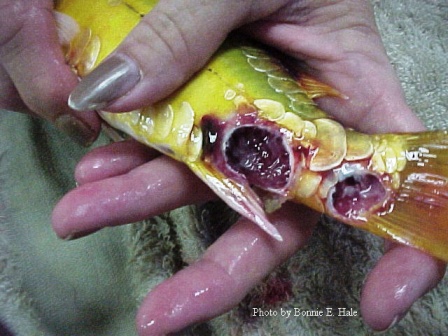
Here are some examples of ulcers. It
had over 14 ulcers on its body that were the size of pencil
eraser to the size of a US quarter. The fish was
"loaded" with flukes.

Ulcer is deep almost to the bone

Above photo shows fish a couple of days later after
only one injection of antibiotics.
One must keep in mind that it is not
the parasites that kill the fish but the bacteria that
sets in one the parasite has breached (bitten) the fish.
For ulcers that are very small or not very deep you can
try one of the following:
|
First you can try
hydrogen peroxide. Soak a cotton ball in the peroxide and
dab the areas. Take great care to hold the fish so that you
do not get the hydrogen peroxide in the eyes, mouth or
gills.
|
High salt .6% (6
pounds of salt per 100 gallons) used as bath for an hour or
so.
|
Potassium
Permanganate (herein referred to PP) will also work. Baths
in PP is rather complicated and is best left to those who
are very familiar with PP and its use. One can very easily
kill the fish if they do not know what they are doing.
|
PP scrubs work
very well. Simply make a paste of PP and water. Pond water
or tap water makes no difference because PP is
self-sterilizing. Place PP granules in a small container
with a lid. This can be used over and over and all you have
to do is replace the lid until the next time you are ready
to use it. Add enough water to make a thick paste. Please
wear gloves and eye protection. There is no way to do the
following procedure and you are going to end up with stains
on your hands that will take several days to wear off. Use a
cotton ball or Q-tip (what you use will depend on the size
of the area) and gently dab the area. Take great care to
hold the fish so that you do not get the PP in the eyes,
mouth or gills. After dabbing the area rinse the fish in
clean water that is preferably pond/tank water. No sense
stressing the fish by using tap water that is not the
temperature the fish is used to being in. Only do this
procedure ONE time.
|
| If you do not see
a vast improvement in the fish in 48 hours, try one of the
alternative treatments listed above. The next day if the
area does not look better it is time to try a different
treatment.
If the fish does not show signs
of improvements with any of the above treatments in a
few days OR looks worse, it may be time to do injections
of antibiotics.
The problem is that unless you can
find a fish friendly veterinarian, you will find it
impossible to find inject-able antibiotics. |

